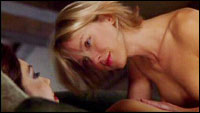The
Waking Narrative : The Degradation and Decline of the Hollywood
Actress
 |
|
|
|
When Rita opens the blue box, Betty becomes
Diane as she, herself, becomes Camilla. This is the waking
narrative of Mulholland Drive. After Diane opens the
blue box, it falls to the bedroom floor of Betty’s aunt. The
woman herself appears and checks the room. The box is no longer
there. The apartment changes. We now appear to be in Diane’s
apartment. She is sleeping. Her slumbering body and slip dress
visually echo the corpse of the primary dream narrative. The
pink of her sheets also alludes to the shot of the bed at
the beginning of the film. Diane’s sleep is interrupted by
the same cowboy encountered by the director Adam and finally
by a woman neighbour of Diane Selwyn whom we encountered in
the dream narrative. Although we now entering the conscious
narrative of Mulholland Drive, it must however be said
that Diane’s “conscious” decline is subject to hallucinations
and hallucinatory figures as it also features a sex scene
which is both dynamic and dream-like. The sex scene is both
a revelation and a narrative shock. Moreover, the configuration
of time in the final 45 minutes of Mulholland Drive
manifests the psychotic edginess of the tormented heroine.
Diane is looking back as she fragments. Woken up by her neighbour
who has come to collect some belongings, Diane notices a “normal”
blue key is on the coffee table. The blue key we will see
belongs to the hitman and signifies that Camilla has been
killed. The neighbour tells us : “By the way, those
two detectives came by looking for you.” What follows
are hallucinations and flash-backs which show the end of love
and reveal Diane’s plans to murder her love. Diane’s dream
is broken. As the cowboy tells Diane : “Hey, pretty
girl, time to wake up”. We see a fading and utterly dejected
woman. The luminous, fair skin of the young blonde woman is
now almost grey. Perhaps Diane has become a prostitute. Possibly
she is a drug addict. Diane encounters the spectre of the
woman we have known as Rita. Rita is now the garishly glamorous
Camilla. She disappears. Diane is confronted by herself. Then,
abruptly, Camilla “actually” returns to and momentarily responds
to a Diane suddenly revived by desire in sexy, “trailer trash”
mode. In Mulholland’s other sex scene, the bare-chested
and jean-clad Diane is more assertively aroused by the voluptuous
temptress, Camilla, who with her painted lips, sculptured
breasts and fuck-me look responds to and then immediately
spurs her female lover’s advances. Diane reacts by forcing
her. The scene is powerful in erotic force and shock value.
It’s unforeseen hyper-reality violently disturbs the sepulchral
slowness of the previous scene. It also exhibits Diane’s extreme
violence. In the next scene, Camilla even provokes Diane’s
sexual jealousy through the acting process. On the set, she
makes sure that Diane sees her kiss the director in rehearsal.
Camilla has left Diane. We see Diane masturbating in teary
despair and anger. She literally beats her sex. The phone
rings. We recognise this phone and setting as that of the
last recipient of a series of calls launched to say “The
girl is still missing”. Diane may therefore be
identified as the unseen and unnamed force pursuing Rita in
the dream narrative. To compound her humiliation, Diane is
invited by Camilla to a Hollywood party on Mulholland where
she and Adam, the young director of her dream announce their
engagement. As the car stops at the house in a scene echoing
the beginning of the film where Rita is driven up Mulholland,
Diane repeats her beloved’s words “We don’t stop here”.
Out of the flora, Camilla appears. Like a full-blooded femme
fatale in an exotic and weird technicolor fantasy, she leads
a desperate and adoring child-like Diane up to the house.
Thus, the tables have been turned. The dark-haired woman is
no longer an injured, sexually yielding amnesiac. At the party,
we here learn a little of Diane’s history of failure as an
actress. She had come to Hollywood from Canada after winning
a jitterbugging contest. She had met Camilla at an audition
for a leading role in “The Sylvia North Story” and
had lost the part to her friend who had subsequently helped
her get a few roles. Diane is patronised by the director’s
mother (played by Anne Miller, the same actress who plays
the friend of her mother - Coco Lenoix - in the dream sequence)
who pats her hand in false sympathy. She is also taunted by
Camilla’s provocative displays of sexual affection with her
fiancée and an ex female lover or lover on the side who is
none other than the young blonde Camilla chosen by the Mafia
in the primary dream narrative. At the party, we see the “espresso”
executive and the cowboy. They are anonymous industry figures.
Rejected by her lover, Diane transforms into a murderess as
Lynch plays with and reverses the noirish Hollywood myth of
the dark homicidal lover. In the apparently archetypal, anonymous
diner which we have witnessed earlier in the dream sequence,
Winkies of Sunset Boulevard, Diane hires the sleazy young
blonde hitman Joe to murder her beloved Camilla. As she shows
her photo to him, the glacial brunette is clearly identified
as Camilla Rhodes. Joe asks her, “Are you sure you want
this ?” Diane answers : “More than anything
else in the world”. Joe tells her that when the deed is
done, he will put a normal blue key on the table. In the diner
two people appear from the primary narrative.
|